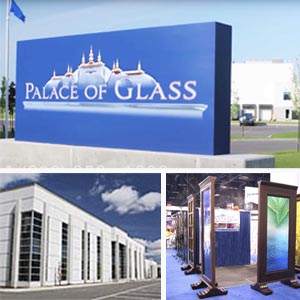Etched Glass is a technique of creating patterns on glass by using external force or corrosive material. It existed for centuries but became widely available in the Europe in mid-1700s. Around 1630’s, diamond engraving invented to be used on mirrors to achieve the etching became in high demand by royal architecture.
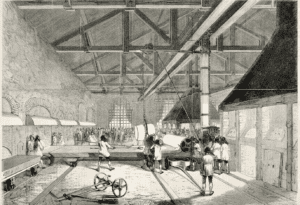
In the mid-1800 it became popular in drinking establishments where visitors could feel private while taking advantage of natural lighting. Victorian and Edwardian traditions quickly adopted the style, and soon enough copper wheel engraving became widely used. There the surface was cut with a copper wheel or disk rotated in a lathe. It quickly became the trend of the day, and many home enthusiast became experimenting with etched glass in their home studios.
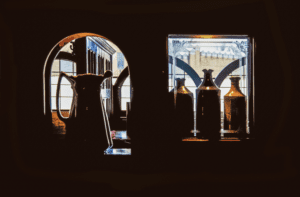
Decorative glass etching in this century
In the late 1920’s, a mold-etch process got introduced in where the designs were etched in the mold so the art was directly transferred to the medium. Glass etching has evolved significantly from the 1920s to the modern day, reflecting advancements in technology and artistic expression. In the 1920s, traditional methods such as sandblasting were commonly used to etch intricate designs onto glass surfaces. Artisans would manually create stencils or use hand-cut templates to guide the abrasive particles onto the glass, resulting in delicate and detailed etchings. Another type of glass etching becoming around that era was glue chipping where adhesive is being applied to the surface that shrinks when drying and causing the surface to peel off in particular pattern.
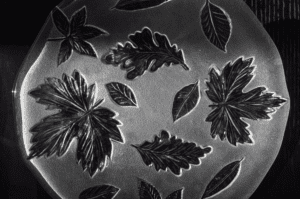
Abrasive Sandblasting
Ability to manipulate with the compressed air allowed craftsmen to master abrasive sandblasting. Shooting the air through a thin nozzle allows to apply very fine particles of sand unto the glass surface to create texturing and shapes. When kept on the same spot for some time pressured sand will create a deeper engraving; also artisan can change the pressure with which air if coming out of sandblasting pen. Usually craftsmen would separate sections wanted for processing with masking tape.

Options for etching on glass
As the decades progressed, new techniques emerged, including acid etching and rotary engraving, which offered greater precision and allowed for more complex patterns and textures. In the late 20th century, the advent of computer-aided design (CAD) revolutionized glass etching, enabling artists to create intricate designs digitally and transfer them onto glass surfaces using laser etching technology. This modern method provides exceptional precision, flexibility, and speed, allowing for the production of highly detailed and customized glass etchings. Additionally, contemporary artists have embraced the versatility of glass etching by experimenting with various materials, such as mirrors and tempered glass, and incorporating mixed media elements to create captivating and innovative works of art. Some decades ago laser etched glass was introduced allowing amazing technical capabilities of etching inside the blocks or dimensional sculptures.
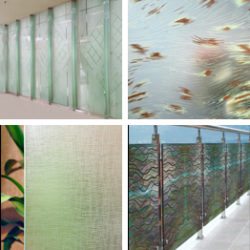
New possibilities opened when water jet cutting allowed glass to be cut in cold environment with a very precise definition and ability to cut curves. It became widely used in stacked glass, signage and logo production. Combined with deep carving or fusing this industrial application becomes also an artistic expression.
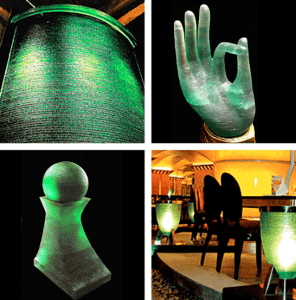
While most etching will simply touch the surface of glass, our team of artisans is well known for deep carved glass, the technique that is also done by applying pressured sand onto the surface. Difference here is that traditional etching simply scratch the surface to create an image but carving goes into the texture of the glass surface to make it dimensional. In addition the glass panels can also be painted over the carving. That is why our award winning designs looks so strikingly alive!
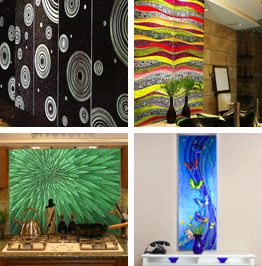
The journey from the manual techniques of the 1920s to the cutting-edge technology of today has expanded the possibilities of glass etching, making it an enduring art form that continues to captivate and inspire.In modern world etched patterns can be seen on windows, partitions, even glassware. Palace of Glass will help you with your needs for design glass from start to finish. We will help understand the styles and kinds of etched glass suitable for your project and create pre-production sketches to visualize your order.
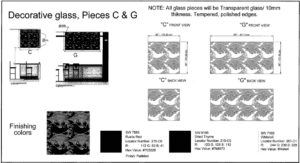
Contact us for free consultation today! As a world leader in art glass production Palace of Glass offers unique and easy opportunities to enhance and beautify your home or business. Tailored mostly to designers and architects our team of seasoned professionals is passionate about bringing to life your next custom glass projects.
